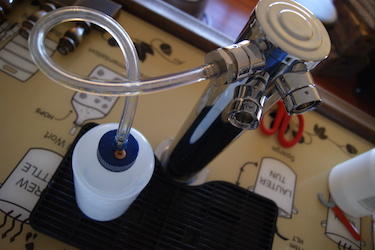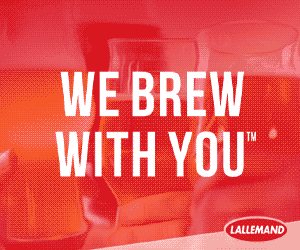Cleaning Your Kegs
Used soda kegs (also called Cornelius kegs or “Corny” kegs, named after one of the keg manufacturers) are a great way to enjoy great homebrew without most of the manual labor of bottling. But, kegging your beer is not foolproof. To avoid time-saving kegging from turning into heartbreaking contaminated beer, proper cleaning and sanitizing is necessary. Also, a little regular keg maintenance is required to keep them in tip-top shape. But, this little amount of extra work for maintaining your kegs still makes kegging the easy choice over the labors of bottling your homebrew.
Buying a Keg
Kegs are widely available at most local and Internet homebrew shops. Checking out your local Pepsi or Coca Cola bottling company may land you a few cheap kegs as well. When buying a keg, you will pay a premium for a refurbished keg and a super-premium for a brand new keg; both options have the advantage that they will most likely be ready to use without any additional effort. Used kegs that have not been refurbished will take a little initial maintenance, but are easily the best deal.
Coke or Pepsi, Pin Lock or Ball Lock
Corny kegs exist in two main styles, referring to the type of inlet and outlet connections on each type of keg: pin lock and ball lock. Pin lock kegs are ones that are used by Coca Cola and are easily identified by the “pins” on the gas and liquid posts on the keg. Ball lock kegs are identified by the absence of pins on the gas and liquid posts and are used by the other soda companies. The “ball” name is derived is from the ball bearings on the connectors that hold the connectors onto their respective posts.
The advantages of one style of keg over the other are minimal and most homebrewers choose by their personal preference. Ball lock fittings and gadgets seem to be more readily available than those for pin lock kegs. Also, ball lock kegs are easily disassembled using regular sockets and wrenches — a special notched socket is needed to disassemble a pin lock keg. Pin lock kegs are slightly shorter than ball lock kegs which makes them more likely to fit in tight refrigerators. Regardless of which style of keg you choose, the parts for each type of keg are not interchangeable, thus a pin lock keg cannot be converted to a ball lock keg and vice versa.
The connections and tools required vary by each manufacturer. For a pin lock keg, a 13/16” deep socket with special notches is needed (check your local or internet homebrew store or make one yourself). The gas/IN post is the one with two pins while the beer/OUT post has three pins. For a ball lock keg, a combination wrench or deep socket will work for disassembly, in either 7/8” or 11/16” size depending on the keg manufacturer. The gas/IN post has notches on the hex base and can have either a 6 point or 12 point base. (Be sure to buy tools in the 12 point style, so that they will work on both types of fittings.) The beer/OUT post has no notches along the 6 point hex base.
Refurbishing an Old Soda Keg
When you get that old keg home, the first thing to do is take it completely apart. Before disassembling, depressurize the keg by pulling on the lever or ring of the relief valve on the lid (or by depressing the poppet on the gas post). Once the keg is depressurized, pull the lid lever and remove the lid by pushing it into the keg then twisting it out.
For each of the connection posts, use either a wrench or deep socket for removal. Use a small screwdriver to press the poppets out of each post. Pull each diptube from the keg. Remove all five o-rings from the diptubes, posts, and lid and discard them.
Rinse all parts and the inside of the keg with water and scrub any rust spots with a Scotchbrite pad. (Do not use steel wool or brushes; they will leave carbon steel deposits that will rust!). Replace each of the old o-rings with new o-rings. Before using the new o-rings, however, boil them in water for 5 minutes to remove the rubbery, solvent-tasting flavor.
Reassemble the keg in opposite order of disassembly. Install the long diptube on the OUT side, matched with the proper 3 pin or un-notched post on top. The diptube should fit just above the indentation or well in the bottom of the keg. When reassembling the posts, be sure that the poppets are firmly in their posts — or at least secure enough that they don’t fall between the posts and the diptubes — while tightening. This will help you avoid damaging the feet of the poppets. When properly installed, the posts need little effort to tighten completely down.
In some kegs, the long beer dip tube does not have a notch to hold it in place. As such, it may spin while you are tightening the post. Be sure to hold the diptube in place while tightening so that the diptube is not jammed up on one side of the keg. The small diptube for the IN side installs similarly, but goes on the notched or two pin post. Finally, place the lid inside the keg and pull down on the lever making sure that the lid is seated directly in the middle of the lid opening and is not shifted to one side.
After complete reassembly, pressurize with CO2 to 25 PSI and check for leaks. Any bad leaks will be heard by the gas hissing out of the fittings. Using a strong iodophor and water mixture, spread over all tightened surfaces including beneath the posts, around the lid and relief valve, and on top of the posts. As an alternative, use a light soap solution or a commercial leak detector solution. For leaks around the lid or posts, either re-tighten the post or lid — or depressurize the keg, remove the leaking fitting, and reinstall it. For leaks around the poppets, reseat by pressing the poppet down with a firm object until the leak stops. Once all leaks are stopped, leave the keg pressurized for a day or two. Check the pressure with a pressure gauge or simply try to apply CO2 at 25 PSI. If there still is a small leak, determine the leaking part and repair or replace.
Maintaining the Keg
Once your keg is in good shape, it is quite easy to maintain. Each time you disassemble the keg for thorough cleaning, inspect each of the parts. Replace any o-rings that are cut or dry-rotted to be sure that a proper seal can be maintained.
If, when assembling the keg, one of the posts will not hold a seal where the poppet seals against the post, first be sure that the post is properly tightened. If the poppet still won’t seal, attempt to reseat the poppet by pressing the poppet down with a screwdriver or other firm object. Use a paper towel to protect yourself from the spray if there is liquid in the keg. If it still won’t seal, then it’s time to change that poppet. (It’s likely the rubber o-ring at the head of the poppet is damaged, one of the feet are damaged, or the spring has worn to the point that it will not expand enough). Many homebrew shops carry a range of poppets for each of the different keg manufacturers. Be sure to check the manufacturer of the keg so that you can choose the proper poppet. Alternately, bring the old poppet with you for comparison when you get your new one.
During use, sometimes it can be increasingly difficult to fit one of the connectors onto the post. When this happens, be sure you are using the proper connector for the post. If it is still difficult (or even impossible) to fit the connector over the post, wet the o-ring with water or apply a tiny amount of Keg Lube or other lubricant meant for beer fittings. The o-ring on the outside of the post may need to be changed if it is damaged or dry-rotted. If a new o-ring doesn’t solve the problem, then the post or connector is damaged and will need to be replaced. Be sure to check the manufacturer of the keg so that you can choose the proper post and poppet combination.
Cleaning and Sanitizing
Cleaning and sanitizing a well maintained keg is critical to protect the beer from contamination, which can cause a myriad of off-flavors. Performing a cleaning step each time before sanitizing is highly recommended. However, periodic cleaning is usually all that is necessary.
To clean the keg, completely disassemble it and soak in a cleaning solution. Five Star PBW is a popular choice amongst homebrewers and works well. After filling the keg with cleaning solution, use the keg to hold all of the other parts including the o-rings. After cleaning, be sure to rinse the keg and all parts well. The keg can be cleaned while assembled, but it is not recommended since cleaners are generally hard to rinse and large yeast or hop deposits can get trapped in the springs of the poppets and can be difficult or impossible to clean without disassembling the posts.
After cleaning, sanitize the keg using a good, no-rinse sanitizer such as Iodophor or Star-san. This can be done while the keg is unassembled or assembled. To sanitize unassembled, just soak each part in the sanitizer in the keg just as was done for cleaning. For sanitizing assembled, assemble the keg, fill with sanitizing solution, and soak. Be sure to press down on each poppet after filling the keg with solution so that each dip tube will release the trapped air and fill with sanitizing solution. If you sanitized the keg assembled, top off the keg if necessary, fit the lid, and push the sanitizing solution out with CO2. The keg is now full of CO2, with little or no oxygen present, and ready to be filled with homebrew.




